How to Deal with Anxiety
Treatments for anxiety include prescription drugs, counseling, meditation and exercise. Experts recommend a combination of these modalities. Experiencing some anxiety when facing difficult decisions or life changes is normal, but when that anxiety interferes with daily life it becomes a disorder.
About 40 million American adults have an anxiety disorder, according to the National Alliance on Mental Illness. This makes anxiety disorders the most common mental illness in America.
Anxiety disorders are characterized by feelings of anxiety that go beyond worrying about everyday things like problems at work or school or dealing with life changes. People with anxiety disorders may have constant, uncontrollable fear that interferes with their lives.
Learn More
Anxiety may also lead to other health problems or habits that may worsen health. For example, people with anxiety may suffer from insomnia, chronic pain or digestive problems. Smoking and vaping is also a problem for people with anxiety, and both of these habits lead to health problems.
People with anxiety and other mental disorders smoke at two to four times the rate of the general population, according to the National Institute on Drug Abuse. They are also twice as likely to have tried e-cigarettes, according to a 2014 study led by Sharon Cummins of University of California, San Diego School of Medicine.
“In my practice, I would say probably 40-ish percent of folks actually have an anxiety issue or disorder,” said licensed mental health counselor and psychotherapist Stacy O’Mara. “Usually for [these patients], that means they are missing sleep.” Treatment is recommended “when they’re at risk of maybe losing a job, losing a partner,” she said.
“I think that there's hope for everybody, and we just have to figure out how to help people feel ultimately empowered and safe.”
Anxiety manifests itself in many ways, from general anxiety disorder to social anxiety disorder. The condition is highly treatable, but less than 40 percent of people who experience anxiety receive treatment, according to the Anxiety and Depression Association of America.
“I think that there’s hope for everybody, and we just have to figure out how to help people feel ultimately empowered and safe and that they do have a predictable, controllable environment,” O’Mara said.
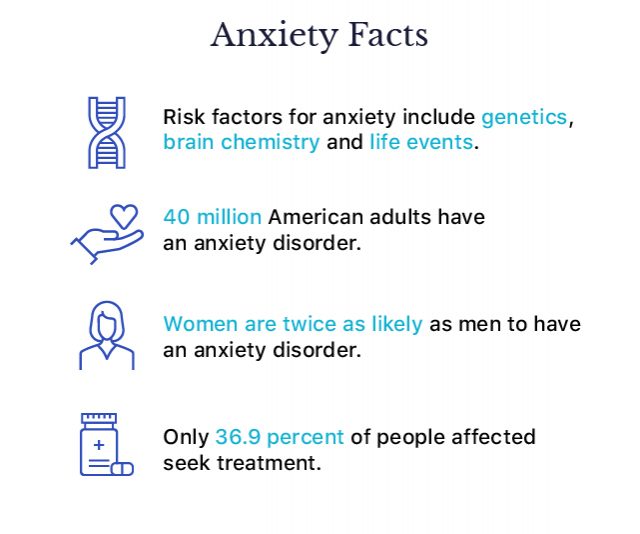
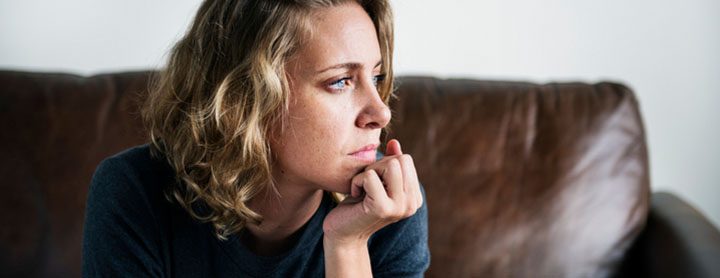
Genetic, Environmental and Traumatic Causes
Mental health professionals aren’t sure what actually causes anxiety. But studies suggest several factors combined may contribute to the illness. These include genetics, environmental stresses, traumatic events and underlying medical problems.
Genetics and Environment
One risk factor for anxiety is genetics. Studies have shown that anxiety disorders may be inherited because they can run in families, according to Cleveland Clinic.
Environmental factors include stresses from not having basic needs met, but some of these basic needs may be out of a person’s control.
“When I don’t have the basics — food, water, safety, security — I am priming myself for anxiety,” O’Mara said. “If I am working a minimum wage job and I don’t have health insurance and I have two kids, being in a constant state of worry, that is going to be a precursor.”
When the body faces severe or long-lasting stress, the brain’s chemistry can change and make an individual more susceptible to anxiety disorders.
People that belong to minority groups such as those in the LGBTQ+ community face constant stress from prejudice and discrimination — a phenomenon called minority stress. LGBTQ+ individuals are 2.5 times more likely to experience anxiety and depression and turn to substance misuse, according to the American Psychiatric Association.
Trauma
Traumatic events such as a sudden death in the family or, war, violence or having to flee a country can trigger anxiety disorders.
According to a 2022 World Health Organization study, the COVID-19 pandemic increased global rates of anxiety and depression by 25 percent.
“Anxiety is the result of the body’s natural ability to alert us to danger and threats outside of our control,” said Támara Hill, a licensed mental health therapist who is certified in trauma therapy. “The body is doing its job to protect and quicken us. However, when a traumatic experience occurs, the body and the brain may respond to external stimuli (i.e., the environment) when it doesn’t need to.”
Women who have experienced sexual assault are more likely to suffer from anxiety and poor sleep than women without the history, according to a 2019 study led by Rebecca C. Thurston of the University of Pittsburgh and published in JAMA Internal Medicine.
Because military veterans face trauma and extreme situations in the course of duty, many develop anxiety which often co-occurs with post-traumatic stress disorder (PTSD).
For example, out of 300,000 veterans who returned from Iraq and Afghanistan, 20 percent reported symptoms of PTSD and major depression, according to a study conducted by the Rand Corporation.
Advertisement
Professional Therapy, Done Online
A licensed therapist with BetterHelp can provide professional support and guidance, on your schedule. Sign up and get matched in as little as 48 hours.
Get Started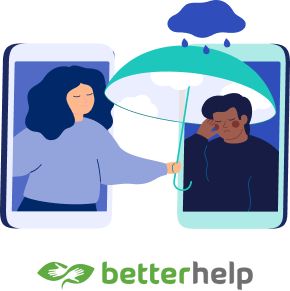
Underlying Medical Problems
In some people, other health problems may cause feelings of anxiety, according to Cleveland Clinic. If you’re experiencing anxiety, a visit to your health care provider can help rule out underlying medical problems.
- Autoimmune disorders (lupus, fibromyalgia, inflammatory conditions)
- Food allergies
- Head trauma
- Heart problems
- Hormones (such as thyroid problems)
- Infectious diseases like Lyme disease
- Medications, herbal supplements, energy drinks and other stimulants
- Neurological conditions
- Poor nutrition (such as vitamin B12 deficiency)
- Tumors
Source: Mayo Clinic
Medications
Some over-the-counter and prescription medications can cause anxiety as a side effect when people start or stop taking them.
Some of the most common medications are birth control pills, weight loss medications, decongestants, steroids, asthma medications and drugs that treat Parkinson’s disease.
Abruptly stopping certain medications like Cymbalta may cause withdrawal symptoms including anxiety.
If you start or stop a medication and feel anxiety symptoms, talk to your health care provider.
GAD and Other Common Disorder Types
Anxiety is a broad term for a variety of disorders. While excessive fear and worry is at the heart of the disorder, it may manifest and be triggered in several ways.
“Anxiety can range from OCD [obsessive compulsive disorder], separation anxiety and generalized anxiety to agoraphobia and severe panic attacks,” said Hill.
The National Alliance on Mental Illness cites generalized anxiety disorder (GAD), social anxiety disorder (SAD), panic disorder (PD) and phobias as the most common types.
Generalized Anxiety Disorder (GAD)
About 6.8 million American adults suffer from GAD. People with GAD are constantly worried about everyday life. It manifests as exhaustion, headaches, nausea and tension. The worrying may last for hours at a time and interferes with daily tasks and life functions.
Social Anxiety Disorder (SAD)
Social anxiety causes extreme fear of social interaction, and it affects 15 million American adults. Most people with this disorder become obsessed with worry about being humiliated in public. Often they are afraid they will say “something stupid” or face judgment from peers.
These fears cause them to withdraw from social situations, isolate themselves, and go out of their way to avoid group activities and conversations. They may also suffer panic attacks in response to social interaction.
Panic Disorder (PD)
Women are twice as likely to be affected by PD, and about 6 million adults in the United States have the condition. The disorder often comes on suddenly and without warning. People feel intense dread and terror, often accompanied by symptoms that mimic a heart attack — chest pain, heart palpitations, dizziness and shortness of breath.
People who have panic attacks will avoid situations and places that might cause another attack.
Phobias
Individuals who suffer from phobias have intense fear linked to a place, event or object. These things are triggers for panic attacks, and people affected work hard to avoid them.
Phobias typically start around age 7, and women are twice as likely as men to experience them. About 19 million people in the United States have phobias.
Common phobias:
- Acrophobia: fear of heights
- Aerophobia: fear of flying
- Arachnophobia: fear of spiders
- Astraphobia: fear of thunder and/or lightning
- Claustrophobia: fear of small spaces
- Cynophobia: fear of dogs
- Emetophobia: fear of vomiting
- Glossophobia: fear of public speaking
- Ophidiophobia: fear of snakes
- Trypophobia: fear of holes
- Xenophobia: fear of the unknown or unfamiliar (such as foreigners)

What Does Anxiety Feel Like?
Anxiety disorder symptoms are emotional and physical. Depending on the type of disorder, the physical symptoms may vary, but all types involve feelings of extreme fear.
Symptoms emerge when the body’s sympathetic nervous system “acts as a gas pedal, speeding up the body’s reaction to anxiety,” Hill said. “Basically the ‘fight or flight’ system causes all the … symptoms of anxiety.”
Doctors diagnosed Rachel Brummert with GAD, PD and post-traumatic stress disorder.
“With the generalized anxiety, it’s a constant state of dread, like something bad is about to happen, only I don’t know what it is,” said Brummert. “It’s a perpetual state of worrying and a heightened sense that danger is around the corner or hypervigilance. When I have a panic attack, I get shortness of breath and chest pains, as if I’m having a heart attack. A sudden, intense and paralyzing fear comes over me and I’ll also shake uncontrollably.”
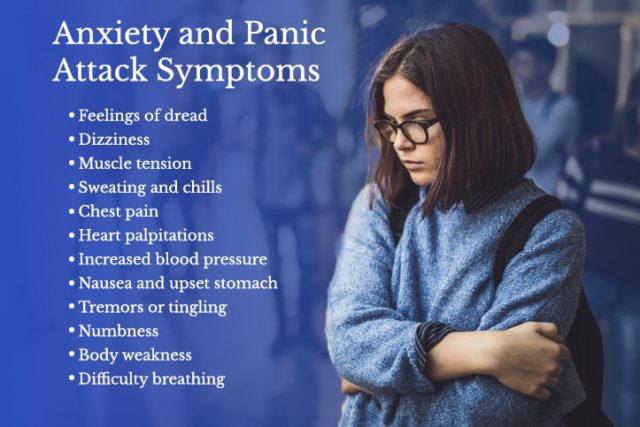
In the case of SAD, symptoms occur in response to impending or forced social interaction. With PD, symptoms may occur without warning, even without anxious thoughts. People may suffer PD in the middle of the night while they are sleeping.
“It is often best to seek treatment as soon as you recognize an increase in symptoms that begins to erode your ability to cope,” Hill advised.
People can start out with consulting their primary care providers and asking for a referral to a psychiatrist or therapist.
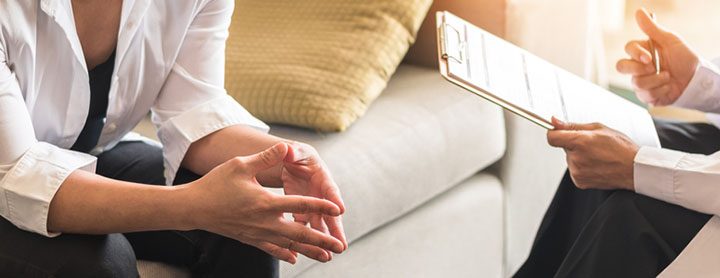
Relief with Medication and Therapy
Depending on the disorder, health providers may prescribe different types of medications to control anxiety symptoms. These typically include antidepressants and antianxiety medications.
| Drug Class | Brand/Generic Name |
|---|---|
| Benzodiazepines | Xanax (alprazolam), Klonopin (clonazepam), Valium (diazepam), Ativan (lorazepam) |
| Selective serotonin reuptake inhibitors (SSRIs) | Celexa (citalopram), Lexapro (escitalopram), Prozac (fluoxetine), Paxil (paroxetine), Zoloft (sertraline) |
| Serotonin-norepinephrine reuptake inhibitors (SNRIs) | Effexor (venlafaxine), Cymbalta (duloxetine) |
| Tricyclic antidepressants | Elavil (amitriptyline), Tofranil (imipramine), Pamelor (nortriptyline) |
Some providers may prescribe atypical antipsychotics such as Risperdal (risperidone), Zyprexa (olanzapine) or Seroquel (quetiapine) off label for anxiety disorders. But the United States Food and Drug Administration has not approved these drugs for this use, and studies show mixed results for safety and effectiveness, according to a review by Dr. Ronald Pies published in Psychiatry.
Therapy
O’Mara recommends that people combine medications with some form of therapy, though either modality can work well on its own.
“If you are having panic attacks, I think pharmaceuticals are good …. I think they should always be [used] in conjunction with therapy. It’s like getting on heart medication but not adjusting your diet or exercise,” she said.
People can get recommendations for licensed counselors or therapists from their primary care provider or through their insurance company. Some therapists specialize in particular types of disorders.
“I think [medications] should always be [used] in conjunction with therapy. It's like getting on heart medication but not adjusting your diet or exercise.”
The most researched psychotherapy for anxiety disorders is Cognitive Behavioral Therapy (CBT). This type of therapy focuses on helping people change their reactions to an event, with strategies that allow people to reduce the beliefs and behaviors that can lead to anxiety.
Eye Movement Desensitization and Reprocessing (EMDR) is a type of psychotherapy that helps people heal from anxiety and PTSD. Several military veterans’ associations, including the United States Department of Veterans Affairs, use it.
It works by using bilateral eye movement and talk therapy to identify traumatic memories and help the individual process them, changing the way they think about traumatic events.
Advertisement
Real Therapy, Done Online
BetterHelp offers flexible scheduling so you can make time for therapy in between meetings, classes, child care, and more. Get 20% off your first month.
Get Started
Dealing with Anxiety Naturally
In addition to medications and therapy, there are several natural ways to help reduce anxiety and create a feeling of calm. These techniques may work for people who don’t want to use medications, can’t use them or are looking for coping mechanisms to add to their medication and therapy plan.
People who want to try to control their anxiety naturally shouldn’t stop taking medications without consulting their health provider first. In some cases, stopping a medication suddenly may cause serious side effects.
Exercise and Yoga
Studies have shown regular exercise can work as well as medication to control anxiety in some people, according to the Anxiety and Depression Association of America. In fact, even a 10-minute walk can make a difference.
Exercise helps alleviate stress and calm the mind by stimulating chemicals in the brain called endorphins. Endorphins create a feeling of calm and a positive mood, according to Harvard Health Publishing.
Exercise doesn’t have to be strenuous to be beneficial. Even gentle yoga focused on meditation can help.
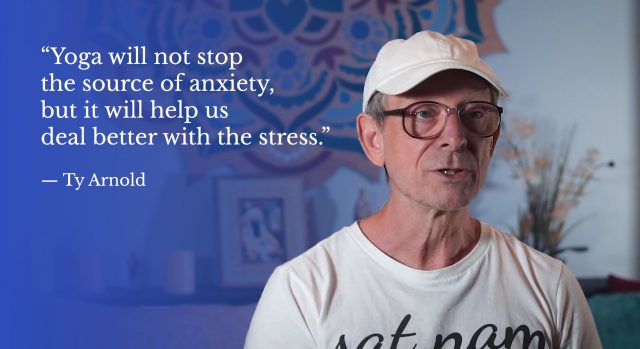
Certified yoga and meditation instructor Ty Arnold has helped several people deal with their anxiety by teaching them to slow down. At 69, Arnold says he is proof anyone can practice yoga and benefit from it.
“If someone approaches me and tells me that they have anxiety issues, I am going to lead them down a path that is far more meditative than athletic because this is someone who needs to learn how to slow down,” said Arnold.
Yoga works by reducing perceived stress and anxiety, according to Harvard Health Publishing. This leads to reduced heart rate, lower blood pressure and easier breathing.
Certified yoga instructors help make sure people practice yoga safely.
Acupuncture
“The very nature of acupuncture is calming,” said licensed acupuncture physician Samadhi Artemisa. “There are specific points on the body for calming the nervous system. We call it the Shen in Chinese medicine.”
Studies involving over 400 patients found that acupuncture often improved symptoms of anxiety compared to conventional treatments, according to Evidence Based Acupuncture.
Research shows that acupuncture releases endorphins and calms the release of neurochemicals implicated in the brain’s response to stress.
If you seek treatment, be sure to find a licensed, certified acupuncture physician or practitioner who has experience working with anxiety symptoms.
Deep Breathing and Meditation
Breathing and meditation techniques can manage anxiety and panic attacks when practiced regularly.
“Deep breathing increases the supply of oxygen to your brain and stimulates the parasympathetic nervous system, which promotes a state of calmness,” according to The American Institute of Stress.
Breathing goes hand-in-hand with meditation. About 30 minutes of meditation each day may improve anxiety and depression, according to a review of studies by researchers at Johns Hopkins.
The 5-4-3-2-1 Coping Technique
The 5-4-3-2-1 coping technique for anxiety allows people to refocus their mind on the present moment and stop fixating on anxious thoughts by using their five senses: sight, touch, hearing, smell and taste.
To use this technique, start by taking a few slow, deep breaths and follow these five steps.
- Step 5
- Look for and notice FIVE things you see around you. Examples: A person, place or thing, like a pen on your desk.
- Step 4
- Look for and notice FOUR things you can touch around you. Examples: The ground under your feet, your hair or your clothes.
- Step 3
- Look for and notice THREE things you can hear. Examples: Music, people talking nearby or birds chirping.
- Step 2
- Look for and notice TWO things you can smell. Examples: Your sheets, food, a pencil on your desk or soap in your bathroom.
- Step 1
- Look for and notice ONE thing you can taste. Examples: Coffee, gum or a sandwich from lunch.

10 Tips on How to Deal with Anxiety
There are a few things people can do when faced with anxiety. These tips involve the body, the mind and the idea of reaching out for help.
1) Accept Things Out of Your Control
Accept that there are things you cannot control. Focusing on the present instead of the unknown future is key to managing and preventing anxiety, said O’Mara.
“Anxious thoughts are all about what’s going to happen next,” she said. “If I am in this moment right now, I can’t be anywhere else.”
2) Learn Your Triggers
Being aware of what triggers anxiety can help you develop coping mechanisms and prevent symptoms.
“I try to recognize the signs early because if I catch it early enough, I can calm it down before it gets away from me. If I don’t catch it early, it’ll spiral and I won’t be able to get myself grounded again for quite a while,” said Brummert.
3) Limit Caffeine and Alcohol
Caffeine, alcohol and other substances like energy drinks or sugary beverages can stimulate the nervous system and increase anxiety and panic attacks.
4) Eat Regularly
Skipping meals can lead to low blood sugar, said Artemisa. Low blood sugar can trigger anxiety because the body produces more cortisol in response to the stress.
She doesn’t recommend fasting or diets that require a very low calorie count for people prone to anxiety.
5) Get Enough Sleep
Adequate sleep helps the body deal with stress. Get at least 8 hours of sleep each night. According to the National Sleep Foundation, lack of sleep can lead to anxiety disorders.
6) Move More
Exercise releases endorphins and helps regulate mood. Just 10 minutes of walking a day can help manage and prevent anxiety symptoms.
Getting enough exercise can also improve sleep and the body’s response to stress.
7) Get Involved in Your Community
Find a way to volunteer or be active in your community.
Science shows that helping others may influence levels of oxytocin in the brains of volunteers, according to a study in Hormones and Behavior by Michael J. Poulin and E. Alison Holman. Oxytocin helps the body manage stress.
Helping others also allows people to focus on something other than their anxiety.
8) Seek Out Support Groups
“Support groups can be great …. When we have a community around us, that is safety and security,” said O’Mara.
These support groups can be found online or in person.
9) Talk to Someone
Don’t be afraid to talk to friends, family, a health provider or a licensed therapist. Since anxiety stems from fearful thoughts, suffering in silence can make anxiety worse.
Getting help can empower people and make them feel less helpless. Taking action and having a plan can give people control over their symptoms.
10) Take a Moment to Slow Down
Take moments throughout the day to relax and center yourself. Deep breathing or taking part in an activity you enjoy can help break the anxiety cycle.
“What would be great is if we practice the deep breathing, the relaxation technique throughout the day,” said O’Mara. “Set an alarm for morning, noon and night for five minutes.”
Take a walk, listen to music, get a massage or practice yoga on your lunch break. Taking mini breaks will help take your mind out of stressful moments and make you more productive, too.
Advertisement
Professional Therapy, Done Online
A licensed therapist with BetterHelp can provide professional support and guidance, on your schedule. Sign up and get matched in as little as 48 hours.
Get Started
Calling this number connects you with a Drugwatch.com representative. We will direct you to one of our trusted legal partners for a free case review.
Drugwatch.com's trusted legal partners support the organization's mission to keep people safe from dangerous drugs and medical devices. For more information, visit our partners page.





